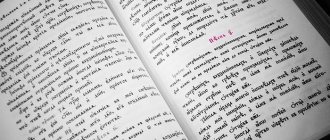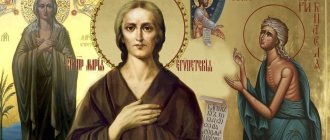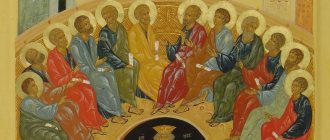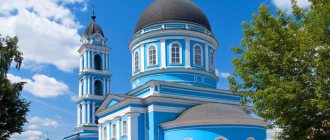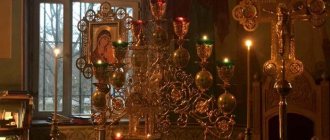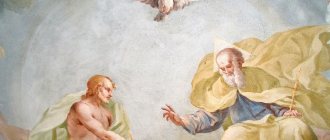Triodion Lenten and Colored
The liturgical sequences of the Easter cycle, that is, the entire circle of moving holidays of the year, are included in the liturgical book Triodion . The name of the book is due to the fact that the canons contained in it for the most part consist not of eight, but of three songs. This canon is called the three song, or “triodion” in Greek. Initially, the Triodion existed in the form of a single collection, and since the 10th century there has been a division into two parts - the Lenten Triodion and the Colored Triodion . The Lenten and Colored Triodions contain services from the preparatory weeks for Lent (the Week of the Publican and the Pharisee, the Prodigal Son, Meat and Cheese Week) until the first Sunday after the Feast of the Holy Trinity (that is, until the Sunday of All Saints).
The Old Believer Lenten Triodion includes services from the Week (i.e., Sunday) about the tax collector and the Pharisee until Lent, that is, ending with the morning service on Friday of the sixth week of Great Lent. Thus, the Lenten Triod contains services performed during Great Lent and in the days of preparation for it. The Lenten Triodion contains chants mainly by authors of the 8th and 9th centuries: Rev. Roman Sladkopevets, teacher. Andrey Kritsky, teacher. John of Damascus, Rev. Joseph the Studite and Theodore the Studite, Emperor Leo the Wise and others. In the 12th century Proverbs are introduced into the prayers of the Triodi; in the 14th century. - synaxari.
The Church begins to prepare believers for the exploits of Great Lent and repentance four weeks before fasting. These weeks (i.e. Sundays) are as follows: the tax collector and the Pharisee, the prodigal son, meat and cheese weeks . People also call the weeks before Lent continuous, variegated and Maslenitsa. Penitential stichera and canons are already appearing in worship, showing believers models and examples of repentance.
The first preparatory week (simultaneously with the beginning of the Lenten Triodion) begins after Sunday and is called the week of the tax collector and the Pharisee, because the gospel parable of the publican and the Pharisee is read at the liturgy (Luke 10: 10-14). This parable inspires us to be humble in prayer and our lives, because only the humble are given the grace of God. A solid week begins, i.e. Meal food is allowed on all days. The Charter indicates the following reason for the abolition of fasting: in the Armenian Church (which recognizes only the first three Ecumenical Councils) a fast was established this week. In contrast to this, the Orthodox, who recognize all seven Ecumenical Councils, should not fast at all at this time. In addition to the Gospel reading, the Church disposes believers to humility and repentance with a special touching chant, which from this day begins to be sung on the following Sundays (ending with the fifth Sunday of Great Lent) at Matins, before the canon.
I think about the many evils I have committed, and tremble at the terrible day of judgment. But trusting in the mercy of Your mercy, like David, I cry to You: have mercy on me, O God, according to Your great mercy.
(Thinking about the many iniquities I have committed, I wait with trepidation, unfortunate one, for the terrible day of judgment; but, hoping for the grace of Your mercy, like David, I cry to You: have mercy on me, O God, according to Your great mercy).
The second week of preparation - the week of the Prodigal Son - is so named because the Gospel parable of the Prodigal Son is read at the Liturgy. This parable teaches us that the Lord is indescribably merciful and is waiting for us, like the prodigal son, to come to Him with a prayer for repentance. This week is popularly called “motley”, because Wednesday and Friday again, as usual, become fast days. Monks and those lay people who “Monday”, that is, fast on Monday, observe three fast days this week. At Matins on this Sunday (and the next two), after “Praise the name of the Lord,” Psalm 186 is supposed to be sung. It depicts the languor of the Jews in captivity in Babylon, when they realized their bitter situation and repented.
On the river Babylon, where we sit and weep, we will never remember Zion. In the middle of it are our two organs. As if you asked us, captivating us with words of song, and leading us with singing. Sing to us from the songs of Zion, as we will sing the song of the Lord in foreign lands. If I forget Jerusalem for you, my right hand will be forgotten. Cling my tongue to my throat, lest I remember you, lest I offer Jerusalem as the beginning of my joy. Lord remember the children of Edom, on the day of Jerusalem, exhaust those who say, exhaust them to the ground. Accursed daughter of Babylon, blessed is he who will give you your reward, just as you have rewarded us. Blessed is he who is and will dash your babies against the stone.
(By the river of Babylon, there we sat and wept, remembering Zion. We hung our harps on the willows in the middle of it (the city). There those who captivated us demanded song from us, and our oppressors (demanded) joy: “Sing to us from the songs of Zion.” ". But how will we sing the song of the Lord in a foreign land? If I forget you, O Jerusalem, let my right hand be forgotten. Cling my tongue to my throat, if I do not remember you, if I do not put Jerusalem at the head of my joy. Remember, O Lord, to the children of Edom in the day of Jerusalem, when they said, Destroy, destroy to the very foundations. Daughter of Babylon, the desolator! Blessed is he who repays you for what you have done to us. Blessed is he who takes and dashes your little ones against the stone).
The Babylonian captivity is an image of our state in captivity of our sins. The infants of Babylon are, according to the explanation of St. fathers - vicious inclinations and germs of disastrous passions born in our soul. We must “break them up”, i.e. overcome, and not be captured by them, like the prodigal son from the parable.
The third preparatory week (the word “week” in Church Slavonic means “Sunday”), according to the Gospel liturgical reading, is called the week of remembrance of the Last Judgment (Matt. 25: 31-46). In order to incite the sinner to repentance, the Church, with the image of the Last Judgment, reminds us that the Lord's judgment awaits us, at which everyone will be rewarded according to their deeds. At the same time, this Gospel reading encourages us to deeds of love for mankind, which we must especially strengthen during the days of fasting and repentance. This week is also called meat-free , or “meat-empty”, i.e. meat is released, because this Sunday ends the eating of meat.
The fourth and last week of preparation (the last day before Lent) is called cheese week . This day ends the eating of milk, cheese and eggs. On this day, the service remembers the fall of Adam and Eve. The first people were expelled from Paradise because they transgressed and violated the commandment of God. We should remember our sins, because preparation for the great holiday of Easter begins with repentance, fasting and prayer. The week preceding this day (cheese week, Maslenitsa) is already half the time of fasting: during it the eating of meat is not allowed, and on Wednesday and Friday there is no liturgy, but only the hours are celebrated and this time with the Lenten prayer of St. Ephraim the Syrian. Also in the Gospel reading for this day it is indicated that true fasting should begin with mutual forgiveness of offenses and insults (Matthew 6: 14-21). This is the basis for the custom of Orthodox Christians on the last Sunday before Lent to ask each other for forgiveness, which is why this day itself is usually called Forgiveness Sunday .
This week the Church even more strongly encourages believers to repent by singing:
Open the doors of repentance, O Life-Giver, for my spirit to awaken to Thy Holy Church. The church is a bodily burden, all defiled, but as if generously cleansed with compassion and mercy. Guide me on the saved path, O Mother of God, for my sins have stained my soul with filth and I have lost all my life in laziness. But through Your prayers, deliver me from all uncleanness.
(Giver of life, open for me the doors of repentance, because since morning my soul has been striving for Your holy temple. True, I wear the entire temple of my body defiled, but You, as the merciful One, cleanse it according to Your great mercy. Mother of God, guide me on the path salvation, because I have defiled my soul with shameful sins and spent my whole life in laziness; but You, through Your prayers, deliver me from all uncleanness).
Lent or Lent begins on Monday. It was installed in memory of the fact that Christ, after his baptism, went into the desert and fasted there for 40 days. A forty-day fast also means that we devote a tenth of our time, a tenth of the year, to God. Forty days is the time from Monday of the first week of fasting to Friday of the sixth week inclusive. Pentecost in the Old Believer liturgical books . Every Sunday of Lent is dedicated to the remembrance of an event in church history or the memory of a saint.
The first Sunday of Great Lent is called the week of the triumph of Orthodoxy . It is dedicated to the memory of the triumph of the restoration of icon veneration in Byzantium in the 9th century, persecuted by the iconoclasts.
On the second Sunday, a service is held for the appearance of the Theodore Icon of the Blessed Virgin Mary according to the charter of the Moscow Assumption Cathedral of the Kremlin.
The third week is veneration of the cross . The rite of veneration of the Cross of the Lord at Matins is according to the same rules as on the Exaltation and on the first day of the Dormition Fast. Remembering the suffering on the cross that the Lord endured for the sake of our salvation, we ourselves must strengthen ourselves in spirit and continue our fasting feat with humility and patience.
On the fourth Sunday, St. John Climacus , who left us one of the most wonderful patristic teachings - the book “The Ladder”. It shows the path of gradual internal ascent to perfection, and also warns about the danger of falling when losing spiritual attention on this narrow and thorny path. The following week, on Wednesday evenings, a service is held with the reading of the Great Canon of St. Andrew of Crete. It contains more than 1000 prostrations and is called “Standing of Mary”. So that the worshipers can rest a little, during the service the life of the Venerable Mary of Egypt is read;
The fifth Sunday is dedicated to the Venerable Mary of Egypt.
Lazarus Saturday, Palm Sunday and the six days of Holy Week already belong to the Colored Triodion.
The Triodion of Colors begins with the service of Vespers on Friday, the eve of Lazarus Saturday, and ends with the Sunday of All Saints, that is, the next Sunday after Pentecost. Its name comes from Vai Week (Color Week), since its beginning is associated with the feast of the Entry of the Lord into Jerusalem.
The first week of the Colored Triodi is Palm Sunday . Then comes Holy Week, during which Orthodox Christians remember the suffering on the cross and the death of the Lord.
And now Great Lent ends, the Feast of Feasts and the Solemnity of Solemnities begins - Holy Easter.
It should be noted that this division of the Triodion was changed during the reform of Patriarch Nikon in the 17th century, and among the New Believers it is now somewhat different: the Lenten Triodion includes worship from the Week of the Publican and the Pharisee to Holy Saturday inclusive, and the Colored Triodion begins from the Week of Easter.
Notes
- Hereinafter the word “week” means 7 days
- Hereinafter the word “Week” means Sunday
- Meat-free Saturday - the penultimate one before Lent
- [www.krotov.info/libr_min/k/krasoviz/kras_17.html Divine Services of the Colored Triodion // Krasovitskaya M. S. Liturgics]
- [old.stsl.ru/manuscripts/staropechatnye-knigi/1054-0 Triodion, eat three song 1784]
- A. A. Lukashevich
[www.pravenc.ru/text/165231.html Annual mobile liturgical circle] // Orthodox Encyclopedia. Volume XI. - M.: Church-scientific, 2006. - P. 669-672. — 752 p. — 39,000 copies. — ISBN 5-89572-017-Х - [old.stsl.ru/manuscripts/staropechatnye-knigi/1069 Triodion or Penticostarion. Lviv 1642]
- [old.stsl.ru/manuscripts/staropechatnye-knigi/1095 Pentikostarion, which is Pentecost Moscow 1795]
- [books.google.ru/books?id=UcYaAAAAYAAJ&pg=PR6&redir_esc=y#v=onepage&q&f=false P. A. Alekseev Church Dictionary. Part three. - M: 1816 p. 153]
- [dlib.rsl.ru/viewer/01004169249#?page=336 “Complete Orthodox Theological Encyclopedic Dictionary” T. 2 1913 in Soykin’s printing house, column 1091]
- [analogion.gr/music/lb/50-pentikostarion Πεντηκοστάριον Χαρμόσυνον (Βενετία, 1860)]
Links
- Triodion // Encyclopedic Dictionary of Brockhaus and Efron: in 86 volumes (82 volumes and 4 additional). - St. Petersburg, 1890-1907.
- [commons.wikimedia.org/wiki/File:Τριώδιον_1586.pdf Τριώδιον.greek, 1586]
- [commons.wikimedia.org/wiki/File:Πεντηκοστάριον.pdf Πεντηκοστάριον.greek, 1890]
- "Color Triodion". 1630. [imwerden.de/cat/modules.php?name=books&pa=showbook&pid=1321 Part 1] [imwerden.de/cat/modules.php?name=books&pa=showbook&pid=1767 Part 2] [imwerden.de/cat /modules.php?name=books&pa=showbook&pid=1769 Part 3]
